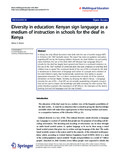| dc.description.abstract | In Kenya, the only official document that deals with the use of mother tongue (MT) in Schools is the 1967 Gachathi report. The report has clear-cut guidance and policy regarding MT use by the hearing children. However, for deaf children, no such policy exists; therefore, the use of the deaf child’s MT (Kenyan Sign Language (KSL)) in schools for the deaf has largely been ignored and there is a continued insistence on the use of the “oral” method of communication that puts emphasis on teaching deaf children how to speak. This continued denial of the use of KSL in schools for the deaf is tantamount to destruction of language and culture of a people and a violation of the deaf children’s rights that fundamentally undermines their ability to acquire appropriate education. This is in direct contravention of article 26 of the universal declaration on Human Rights. Similarly, by denying the deaf in Kenya – a language minority the use of KSL – their MT, we are actually squandering a linguistic resource that can be used to impart the knowledge and skills necessary for their survival. This article therefore examines the importance of MT (KSL) in the education of the deaf in learning 2nd and 3rd languages and the way forward. | en_US |

